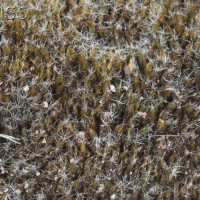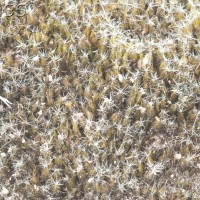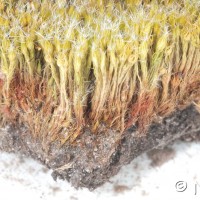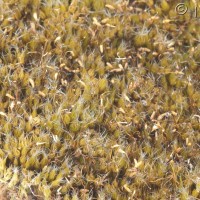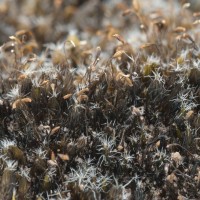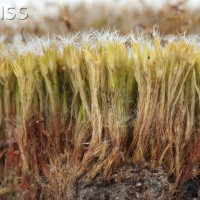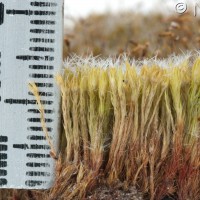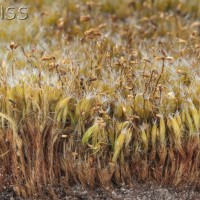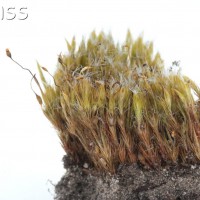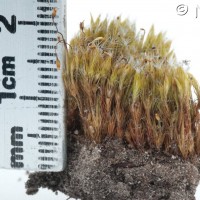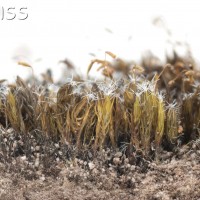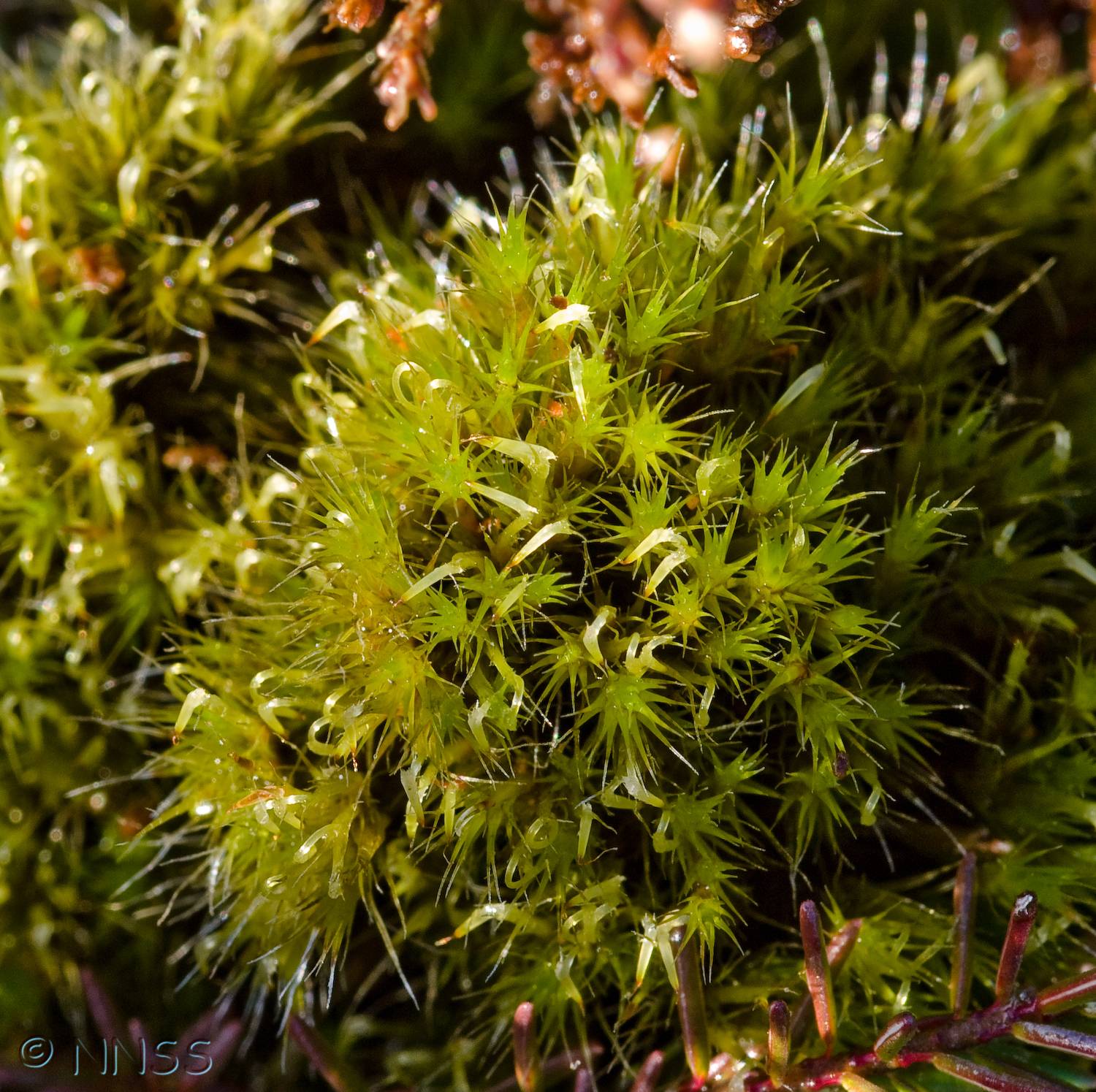
Heath Star Moss - Campylopus introflexus
Expand and collapse the sections below by clicking on the title or + / - icons.
Short description of Campylopus introflexus, Heath Star Moss
A moss with erect shoots 1-5 cm high, forming blackish-green turfs or tufts. The leaves end in a hair point, which is erect when moist but bends back when dry. Capsules frequent, on bent stalks.
Impact summary: Campylopus introflexus, Heath Star Moss
C. introflexus appears to do little long-term damage to the environment. It rapidly colonizes disturbed or burnt peat, dominating in the early stages of succession.
Habitat summary: Campylopus introflexus, Heath Star Moss
It is a calcifuge, most abundant on bare peat or raw humus after burning or other disturbance such as bracken control. Other habitats are thatch, fence posts and rotting wood.
Overview table
| Environment | Terrestrial |
|---|---|
| Species status | Non-Native |
| Native range | Southern Africa, Australia |
| Functional type | Land plant |
| Status in England | Non-Native |
| Status in Scotland | |
| Status in Wales | |
| Location of first record | Washington (13) |
| Date of first record | 1941 |
Origin
It originated in the Southern Hemisphere, but the source of European populations is not known.
First Record
West Sussex, on Heath Common, Washington, 1941
Pathway and Method
Not known. Presumably introduced with produce or raw materials imported by ship.
Species Status
Widespread throughout Great Britain. It had fully colonized the territory by about 1990 and its distribution is now stable.
Dispersal Mechanisms
Long-distance dispersal is by spores, which are carried by wind probably over hundreds of kilometres. Short-distance dispersal is also by shoot fragments, which readily become detached and scattered over a few metres by wind and grazing livestock.
Reproduction
Capsules and spores are produced abundantly by large populations of C. introflexus. It is dioecious, so isolated tufts may not produce capsules.
Known Predators/Herbivores
Its leafy shoots, like those of most mosses, are little grazed. There are no specific observations of it being consumed by herbivores in Great Britain.
Resistant Stages
Longevity of spores is not known, but their relatively small size 10-14 μm and thin cell walls suggest that they probably do not persist for long in the soil.
Habitat Occupied in GB
It is a strong calcifuge, never found on calcareous or basic substrata. On heaths and moors, the main habitat is disturbed peat and raw humus both in exposed sites and in partial shade. It is noted as a rapid colonist after heathland fires. It also occurs on humus in crevices of acid rocks and readily survives complete desiccation in full sunshine. In the lowlands, it is found in woods, stumps, old bark and rotten wood, sometimes in considerable shade. Other habitats include acid sand dunes, thatch, slates, fence posts and rotting gates.
Common throughout Great Britain, mainly at low altitudes and not found above 640 m.
Environmental Impact
It rapidly produces a stablilized moss crust after disturbance such as heathland fires, peat digging and bracken control. Such crusts suppress the germination of vascular plant seeds, notably heather, but also protect them from disturbance and frost heave if they do successfully germinate. Campylopus introflexus is a pioneer, with little or no longer-term impact in later successional stages. In early to mid succession, it may reduce the abundance of Cladonia lichens and other pioneer mosses such as Campylopus brevipilus and Ceratodon purpureus. On thatch. it may compete with the endangered Thatch Moss Leptodontium gemmascens but the effect is probably a small one.
Health and Social Impact
None known. The beauty of its shoots has been celebrated in photographs, for example on the cover of the British Bryological Society's most recent Census Catalogue (Hill et al., 2008).
Economic Impact
Probably none. Like other mosses, it may fall into gutters from roofs. Because it does not seem to prevent heather regeneration, it is not a threat to management of grouse moors.
Identification
Atherton, I., Bosanquet, S. & Lawley, M. eds (2010) Mosses and liverworts of Britain and Ireland - a field guide. British Bryological Society. (p. 400).
http:commons.wikimedia.orgwikiCampylopus_introflexus
Biology, ecology, spread, vectors
Hassel, K. & Soderstrom, L. (2005) The expansion of the alien mosses Orthodontium lineare and Campylopus introflexus in Britain and continental Europe. Journal of the Hattori Botanical Laboratory, 97, 183-193.
Pakeman, R.J., Le Duc, M.G. & Marrs, R.H. (1997) Moorland vegetation succession after the control of bracken with asulam. Agriculture, Ecosystems & Environment, 62, 41-52.
Management and impact
Equihua, M. & Usher, M.B. (1993) Impact of carpets of the invasive moss Campylopus introflexus on Calluna vulgaris regeneration. Journal of Ecology 81, 359-365.
General
DAISIE factsheet http:www.europe-aliens.orgspeciesFactsheet.do?speciesId=54Hill, M.O., Blackstock, T.H., Long, D.G. & Rothero, G.P. (2008) A checklist and census catalogue of British and Irish bryophytes updated 2008 British Bryological Society.
Spotted this species?
Distribution map
View the Distribution map for Heath Star Moss, Campylopus introflexus from BSBI


